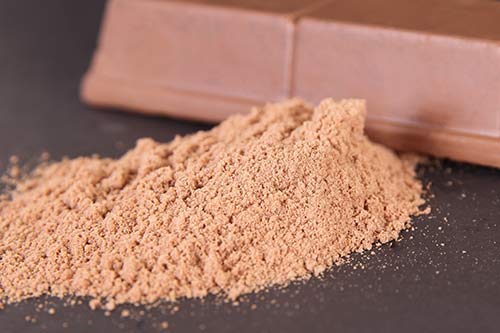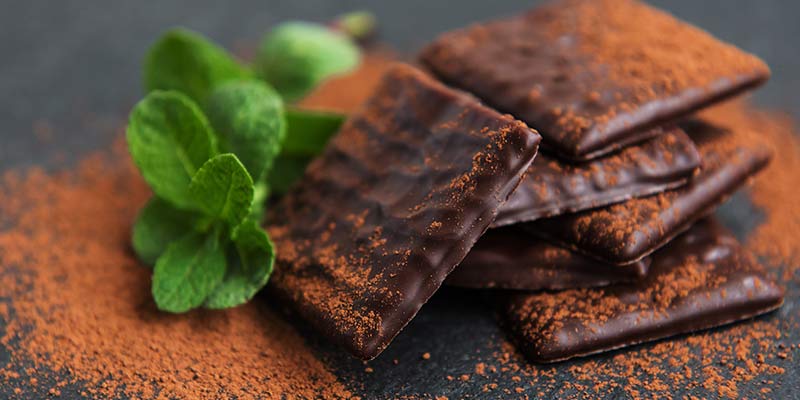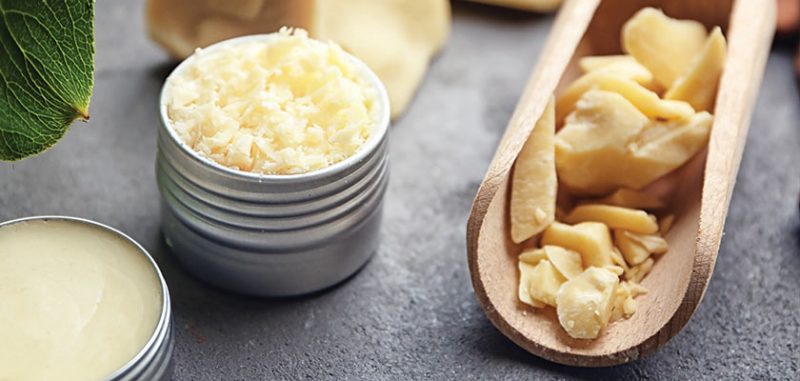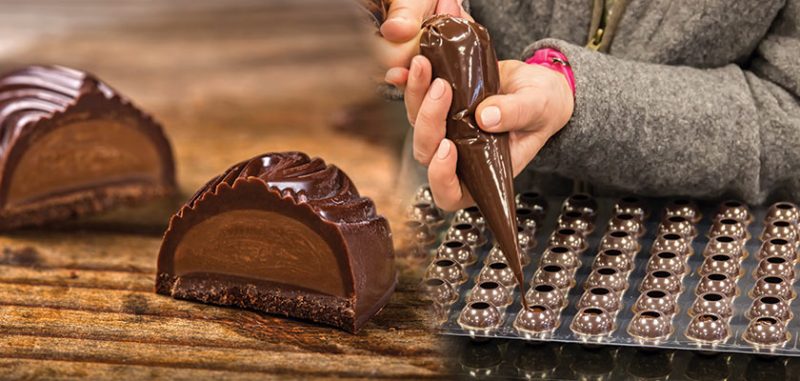Ready to learn how to make vegan chocolate from scratch? In this guide, professional chocolatier Simon Knott steps you through the process of making vegan homemade chocolate, from choosing ingredients, to tempering and molding.
Whether you are making vegan chocolate for yourself, for sale in your home business, or as a lovingly-crafted gift for a friend, having a good understanding of both the principles of chocolate-crafting, and how to use plant-based substitutes for some ingredients is crucial. In this article, Simon explains how to select ingredients for vegan chocolate making, and how to make vegan chocolate easily with dairy-free and cruelty-free substitutions.
How to Make Vegan Chocolate from Scratch: Step-By-Step Guide
By Simon Knott, Professional Chocolatier
Vegans new to the diet can easily assume that a chocolate bar with ‘milk’ in the title will be excluded. However, delicious vegan chocolate bars are within everyone’s reach with simple modifications and using readily available ingredients. It’s also possible to temper the recipe as you make it with cocoa butter so it will be more robust when it sets and have a good shine.
Ingredients for Making Vegan Chocolate
Cacao/Cocoa
Cocoa powder can be either natural/unrefined or Dutch-processed. Natural cocoa retains the natural acidity from the cocoa beans, while Dutch-processed cocoa is treated with alkaline to reduce the acidity.
Cacao powder is manufactured from roasted cacao beans that are ground finely. It has a more authentic cocoa flavour but is significantly more bitter than cocoa powder. Cacao powder is more expensive than cocoa.
Which you choose comes down to personal choice. If you use 100% cacao powder, the sweetener in the recipe must be increased to counteract the extra bitterness. Many find that a 50:50 ratio of cacao and cocoa is a good compromise, offering good flavour without too much bitterness and at a reasonable price.

Sugars & Sweeteners
Refined sugar is usually the first choice for chocolate recipes. However, sugar processing often includes an element of whitening, where bone char or natural carbon is used to decolourise the sugar. Bone char is a byproduct of the meat industry from cattle bones and is consequently not regarded as vegan. If you are intent on learning how to make vegan chocolate with sugar, make sure to look for white sugar that is certified vegan.
There are, however, several practical alternative sweeteners:
Agave syrup or nectar is produced from the same succulent plant as tequila. The syrup is amber in colour, and darker strains have a caramel flavour. It is about 40% sweeter than sugar, so use about half as much agave as sugar in a recipe.
Stevia is native to South America and has gained enormous popularity recently. Extracted from the Stevia rebaudiana plant, it creates a sweetener 300 times sweeter than sugar but with no calories. Consequently, very little is needed in recipes, so adding another ingredient to make up the volume is often necessary. Some producers like to bulk Stevia with either inulin, a natural soluble fibre or allulose, a natural sugar found in raisins and figs.
Maple Syrup, as a natural sweetening substitute for vegan chocolate, it incorporates well without graining, and its mild taste complements chocolate flavours. Worldwide, maple syrup production is quite limited, making it one of the more expensive sweeteners.

How to Make Vegan Milk Chocolate (Dairy Alternatives)
The following can be used as replacements for dairy milk powder when experimenting with how to make vegan milk chocolate. They are best incorporated as powders at the same time as the cocoa powder before the cocoa butter is tempered.
Full-fat Coconut milk/powder – a popular substitute for how to make chocolate vegan. The high-fat content of full-fat coconut milk requires lessening the cocoa butter content in recipes. Otherwise, the excess fat in the finished chocolate will cause it to be unpleasantly oily and difficult to temper.
Rice Flour – is high in carbohydrates and acts as a thickening agent to give vegan chocolate the required rich texture. It has a very mild flavour and incorporates well with other ingredients.
Green Banana Flour – creates a smooth texture with a very mild banana flavour when used to make vegan chocolate. It is similar to all-purpose flour, performing well with cakes, biscuits and bread but also gluten-free.
Oatmeal Flour – a nutritious and very mild-tasting flour that acts as a good milk substitute.
Lucuma Powder – The lucuma fruit has green skin, yellow-orange flesh, and a large stone in the centre, like a mango. The flesh is dried to a light brown powder that tastes a little like maple syrup and brown sugar. It adds creaminess to vegan chocolate and is often paired with stevia, as it is only mildly sweet.
How to Make Vegan Chocolate (Recipe)
This recipe for how to make vegan chocolate uses cocoa/cacao powder as the starting point, to cater to all level of cooks. However, you can make vegan chocolate from raw cacao pods or cacao beans by following our recipe for bean-to-bar chocolate making here. Simply make the appropriate vegan substitutes as described in this article, to craft your bean-to-bar vegan chocolate.
Equipment
- Mixing bowl
- Fine sieve
- Whisk
- Cheese grater
- Spoon or small jug for pouring
- Spatula
- Moulds – silicone or polycarbonate
Ingredients
For vegan dark chocolate:
- 1 1/4 cup (270g) finely chopped cacao butter
- 2 tbsp coconut oil
- 1 cup (120g) cacao or unsweetened cocoa powder
- 2 tbsp maple syrup
- 1 pinch sea salt (optional)
- 1/2 tsp vanilla extract
- Add-in ingredients (eg nuts, dried fruit)
For vegan milk chocolate:
In addition to the above ingredients, mix in ½-1 tsp lucuma powder – or other dairy replacement mentioned earlier – with the cocoa powder.

Method for How to Make Vegan Chocolate
Step 1: Prepare the add-ins or mix-ins.
Chop the add-ins into small pieces so they distribute well in the bar.
The possibilities for adding decorative finishes to your chocolate bars are endless. Traditional ingredients include dried fruit and nuts (raisins, almonds, pistachio), freeze-dried fruit pieces, spices (cinnamon, cardamom), oil flavourings (mint, orange), and pieces of crushed biscuit (digestive, Graham Cracker) or for an authentic finish try crushed cacao nib pieces for crunch and extra chocolate flavour.
Step 2: Prepare the moulds for the chocolate.
Various moulds can be used to form the vegan chocolate bars. The key to remember is that they should be perfectly dry and clean. Silicone moulds are cheap and easy to use, while polycarbonate moulds produce a much glossier finish on the chocolate.
Wash the moulds in soapy water before use and dry carefully with a cloth or cotton wool. Once completely dry, use a fresh piece of cloth to polish the interior of the mould. Creating a polished, clean surface will produce a chocolate bar with a good shine that can easily be extracted from the mould.
Step 3: Prepare the chocolate mixture
Melt the chopped cocoa butter and coconut oil gently in a double boiler. Mix in the maple syrup. Remove the pan from the heat. Sift the cocoa powder and add it to the pan. If making vegan Milk Chocolate, add the non-dairy alternative at this point.
Use a small whisk to mix the ingredients. Stir in the vanilla. Test the sweetness of the mixture and add a little more maple syrup if needed.
Step 4: Tempering the chocolate
In attempting to temper your vegan chocolate from scratch, you won’t have any seed chocolate to temper it with. Luckily, it’s possible to use another tempering method, which introduces small pieces of cocoa butter to the mixture to initiate the same tempering process.
Bring the chocolate to 90°F for dark chocolate. Calculate how much cocoa butter you need – 1-2% of the total ingredient’s weight. Grate the cocoa butter into small pieces. Maintaining the same temperature, stir in the cocoa butter pieces.
Once fully incorporated, the chocolate should be tempered.
Step 5: Moulding the Vegan Chocolate
Once the chocolate is fully mixed, it must be poured into the moulds immediately. As you only create a thin layer to form a bar, it will start to set quickly. Pick up each mould and drop it onto the table from about 3 inches. This will dislodge any air bubbles, which can be pricked with a cocktail stick on the surface.
Step 6: Decorative Finishes
If you are stirring your add-ins or mix-ins through the chocolate, add these to the mixing bowl and stir with a spoon. As the add-ins will lower the temperature of the chocolate, so pour the chocolate into the mould as soon as possible. Using a small jug to transfer the chocolate from the bowl to the mould is usually the quickest and most accurate.
If you sprinkle your add-ins or mix-ins over the chocolate, pour the chocolate into the moulds and scatter the fruit and nuts. Pick up each mould from the table and drop it from a height of about 3 inches, which will help the add-ins settle into the chocolate surface and release any air bubbles too, which can be popped similarly.
Step 7: Cool and store
As the vegan chocolate bar is tempered, it should set at room temperature unless the ambient temperature is very high. If so, cool it for 30 minutes in the fridge, wrap it, and store it in a cool, dry place.
Conclusion
There you have your hand-crafted vegan chocolate. We hope you’ve enjoyed this article from chocolatier Simon Knott on how to make vegan chocolate. If you’ve enjoyed this piece, be sure to check out our related article on what styles of chocolate are vegan, where Simon explains what types of chocolate are better suited to vegan chocolate crafting (and of course, eating).
If you want to explore more on how to make vegan chocolate treats and gifts, check out our article on how to make your own hand-crafted chocolate bar using couverture with a vegan twist, by swapping out the regular couverture with one of these new professional-standard plant-based couvertures from manufacturers Barry Callebaut (Belgium) and Valrhona (France).
Happy plant-based chocolatiering!








